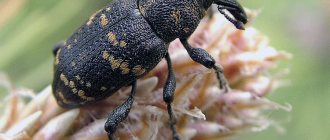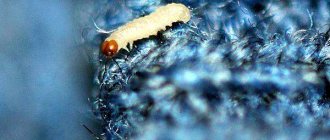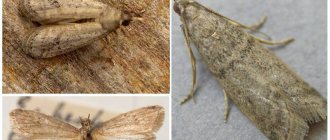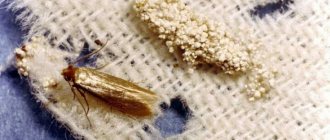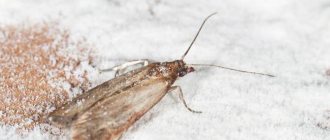What grain moth looks like (photo)
Description of the pest
Name: Granary moth, Grain or Bread moth Lat.:
Nemapogon granellaClass: Insects - Insecta Order: Lepidoptera - Lepidoptera Family: True moths - Tineidae
| Habitats: | grain storage, house and apartment |
| Dangerous for: | grains, crackers, dried mushrooms |
| Means of destruction: | heat treatment, traditional methods, chemicals |
The white grain worm (grain moth) is a butterfly belonging to the moth family and is a pest of grain stocks. It also destroys the following products:
- mushrooms;
- crackers;
- planting material.
Granary moth larva.
The pest's habitat is: granaries, residential buildings. The insect has the following appearance: the front pair of wings are gray in color with a few dark inclusions. The hind wings are brown with a slight fringe, the wingspan is 14 mm.
The length of the caterpillar reaches 10 mm, the color is yellow, the head is brown. Within 12 months, 2 generations of the barn pest develop.
During the cold season, the parasite lives in a cocoon. Insects belonging to the 1st generation hatch in March. The female infects the grain by laying eggs.
Types of house moths
Moths are one of the most common insects that are found in all corners of the planet. Small gray moths are quite inconspicuous, which serves as an ideal camouflage.
It is worth saying that gray moths do not pose a danger to food, wool and fur products, furniture, and carpets. The fact is that in adult individuals the oral apparatus and digestive tract are deformed and throughout their short life they do not feed at all.
They live off the nutrients they receive during the larval stage of development. It is the voracious larvae that pose a danger because they can cause enormous damage.
There are two types of moths found in residential areas:
- Food.
- Clothes.
If an infestation is detected, you will need to resort to complex actions that will help get rid of not only adult moths, but also clutches of eggs and larvae. Don't waste time and hope that the insects will simply disappear. Losing time threatens even greater losses, because moths multiply very quickly and it is much more difficult to fight a huge number of insects.
Regarding the external characteristics of food moth larvae, they are very similar to small white worms, the head is brown or black, and they have 6 pairs of legs. The larva can be 6-12 mm long and about 1-2 mm wide.
The larva's diet is quite varied; it can eat cereals, grains, legumes, flour, nuts, dried fruits, cookies, sweets, and confectionery. You can see what the larva looks like in the photo.
If an infestation is detected, you will need to go through the contents of all kitchen cabinets. Signs include the presence of lumps of small grains in cereals, flour, also on dried fruits, in legumes, paths and tunnels are visible that have been eaten by voracious caterpillars.
Contaminated products contain cobwebs, visible scales that remain after the caterpillar moults, and insect waste products.
It is worth saying that in appearance the larvae of clothes moths are very similar to food moths, only the habitat of these pests differs. They are not at all interested in food supplies, so you won’t find them in kitchen cabinets. They can be found in dressing rooms, furniture, bookcases, sofas, and carpets. There are 2 subspecies of these insects, furniture and fur.
As a rule, owners find out about an infestation with these insects by spoiled things or by observing moths fluttering in the room. They are nocturnal and hide in secluded corners during the day.
You can also see larvae, pupae, and cobwebs on things. If an infection is noticed, effective control methods must be used immediately. You will need to go through all the closets with clothes, shoes, textiles, inspect bookcases, carpets and furniture. It is not enough to simply get rid of the adults, because a new generation is growing up in the closet and needs to be destroyed.
How does this parasite appear?
Grain moth is a common type of crop pest. Lives in grain warehouses, mills, apartments, stacks and currents.
The development cycle of the pest has a certain peculiarity: the caterpillar grows unnoticed, because it is located inside the grain. Eggs are formed within 28 days. Sometimes their ripening period is 4 days and depends on the temperature. They tolerate low temperatures and high humidity. The hatched caterpillar is mobile and spends a lot of time on the surface of the grain.
Grain moth on the surface.
In one rye seed, 1 caterpillar settles; in a corn grain, their number reaches 2-3 individuals. The hole through which the pest entered the seed is stained with excrement.
The parasite destroys the floury supply of cereals, forming a cavity filled with cobwebs. It divides the grain into 2 chambers: the first contains the caterpillar, the second contains the products of its vital activity.
The caterpillar lives inside the cereal until the end of its development. At an ambient temperature of +10...+12°C, the pest is in a state of hibernation, which lasts 5 months. The grain moisture required for the existence of the caterpillar must be at least 15-16%.
How to deal with larvae?
So, having learned about moths, we can say that the greatest harm is caused by an individual at the larval stage, but at the same time, the fight must be waged against insects at all stages of development. After all, new caterpillars emerge from clutches of eggs, adults emerge from cocoons, and moths hatch eggs.
To combat these pests, mechanical methods, chemicals and folk remedies are used; in addition, it will be necessary to resort to preventive measures to prevent new infections.
At the first stage, mechanical control methods are used to get rid of eggs, larvae and pupae. This will require a thorough inspection of food supplies, in the case of food moths, and clothing, in the case of clothes.
If food products are contaminated, you need to carefully inspect all cereals, flour, nuts, dried fruits and other food supplies; throw them away. Products that are in doubt should be processed with heat or cold.
You should preheat the oven to 60° and place the product in it for 40 minutes, or put it in the freezer for several days. Next, all kitchen cabinets need to be thoroughly vacuumed, paying special attention to cracks and corners. Afterwards, wash the cabinets with soap or vinegar solution, as well as all containers and storage containers.
In the case of clothes moths, you will need to go through all the things in the wardrobe, shoes, bedspreads, pillows and other textiles that are stored in closets. Particular attention is paid to things that are stored for a long time and not ventilated.
If possible, items are washed and hung outside for several days. If it is not possible to wash all the items, they can be sent for airing. Direct sunlight, just like frost, has a detrimental effect on insects.
At the second stage, specialized means are used, but much depends on the degree of infection, as well as the habitat of the pest. Since food moths are found in the kitchen, where food and utensils are present, chemicals are used as a last resort and only to get rid of adult moths.
These drugs include sprays and aerosols, which are the most effective among all forms of release.
Sprays and aerosols are also used in the fight against clothes moths, for treating cabinets and furniture. When using them, you should always remember that they are toxic and, if safety precautions are not followed, pose a danger to the health of people and animals.
During the treatment, all family members and animals must leave the apartment, only the one who carries out the procedure and uses personal protective equipment remains. After treatment, you need to leave the room for several hours, upon return, thoroughly ventilate and wash all surfaces.
To get rid of adult individuals, you can use fumigators, which show fairly high efficiency and do not pose a danger to people and animals. They are popular due to their ease of use and effectiveness. After turning on the fumigator, the active substance begins to heat up, the toxic fumes quickly affect insects.
In the kitchen you can use traps that kill males. They use a female pheromone to attract males. At first glance, it may seem that traps are of little use, because they only allow you to get rid of males.
But this is not entirely true, because without males, females cannot reproduce, which means there will be no new clutches of eggs. Sections and tablets can be placed in the wardrobes, which affect adult individuals and prevent the possibility of laying offspring.
Folk remedies are very popular in the fight against moths and show good results. They are non-toxic and completely safe, so they can be used in the kitchen. You can use lavender, wormwood, mint, which have rich and bright aromas and are not tolerated by pests.
To do this, plants need to be placed in small rag bags and laid out on the shelves of the closet. You can also use garlic, the aroma of which is also not tolerated by moths. Citrus peels have the same repellent aroma.
Remember that all these products lose the intensity of their aroma over time, thereby reducing their effectiveness, so you will need to regularly replace them with new ones. In the kitchen you can put a pot of geraniums, which are an ideal remedy for moths.
How harmful and dangerous are moths?
Grain moth.
The white breadworm is a pest that destroys wheat, barley, oats, rice, sorghum, legumes, etc. Peas are damaged by granary moths only if the cereal is stored at a humidity of 14%.
The pest destroys the surface layer of seeds to a depth of 20 cm. When the grain is completely damaged by bread moths, during the period when the moths emerge, the temperature of the grain increases, and areas of self-heating and caking are formed.
The first stage of damage to cereals is not immediately detected, since the entrance hole in the damaged grain is small.
Treatment of infected seeds does not always destroy the pest; it ends up in the granary along with the grain. Soon the caterpillar turns into a pupa, from which a butterfly is formed that lays eggs. The barn pest stays in the warehouse until the grain supplies run out.
Life cycle features
The life cycle of an adult lasts from 3 days to two weeks and during this entire period the butterfly does not eat anything, only drinks water.
Sitting on the surface, the moth selects a suitable environment for laying eggs, from which, over time, hatch larvae capable of absorbing this very environment with amazing speed.
Having emerged from the egg, the larva gnaws through the grain and penetrates it: there it finds both housing and food. By the time the larva is ready to turn into a butterfly pupa, the grain is a cavity, in one part of which the caterpillar itself is located, and in the second, smaller part - its excrement.
It is the grain moth larvae that pose the main danger and during the growth process they turn into relatively large caterpillars.
Thus, you can find translucent grains in your cereals, inside of which a well-fed caterpillar is visible in the light. You can eat such cereals with appropriate temperature treatment. But only a few will be able to force themselves to eat such “delicacies”; in addition, the waste products of the larvae contain urate and oxalic acids, which are dangerous to the human body.
Barn moths and similar species of insects multiply at a catastrophic rate. If today you find larvae in a bag of flour, then in a few days they will be in buckwheat, rice, pasta and other bulk products.
The main problem in controlling these insects is the difficulty of quickly identifying their occurrence, thereby preventing the spread. If you notice a similar moth, then it could be either the first scout or a new offspring that has grown in your cupboard with cereals.
Ways to fight
What are the best anti-moth products?
ChemicalFolk
The following methods are used to combat grain moths:
- airing spoiled forage;
- heating the grain to +60°C;
- cleaning the granary;
- use of fumigants;
- use of disinfected cereals;
- timely threshing of grain.
Grain is stored in special rooms protected from rodents and birds. New harvest grains are not mixed with last year's grain. The degree of moisture content of the products is determined and the storage is cleaned.
The grain should not come into contact with the outer covering of the walls to prevent waterlogging and mold formation. It is necessary to monitor temperature and humidity indicators, taking into account the time of year.
If granary moths are found in a room, the following measures are taken:
- treat warehouses and storage facilities with chemicals;
- carry out mechanical cleaning;
- expose the grain to high temperatures;
- use fumigants to treat crops;
- carry out disinfection using aerosols.
Cooling stocks
There are 3 ways to store grain:
- dry;
- cooled;
Grain needs the correct storage temperature.
- airless.
On farms, cereals are stored refrigerated. This method prevents the loss of crops and pests die. To cool products, exhaust ventilation is used, which operates around the clock.
Cooling the grain preserves the new harvest. The temperature range is from 0 to +12°. In this case, a slight decrease in the weight of the cereal is observed, amounting to 0.1%.
Pests degrade the quality of the product. If the grain temperature is less than +19°C, the activity of the grain moth increases. Harvest safety is ensured by a temperature of +12°C and humidity of 18%.
Heating the grain
In order to preserve the grain, it is subjected to processing, which is carried out in elevators. Special dryers are used. For each crop, the temperature regime is determined.
Before heating the forage, it must be cleaned. The moth dies at a temperature of +55°C, treatment lasts from 10 minutes to 2 hours.
The seed material is not heated, since the pests do not die. To achieve 100% results, two-stage heating is used. Dry grain is put into the dryer twice and then checked for pests.
Grain cleaning
The grain is cleaned using the separation method.
Grain moths are removed using the method of separating one batch of produce from another. Separation allows you to destroy the grain moth, which is located in the space between the seeds. This method is not used if it is necessary to process infected grain with a pest inside.
Contaminated cereals are cleaned using special machines with aspiration systems that prevent the spread of harmful substances into the environment. They destroy moths in winter, while simultaneously cooling the grain.
They do not control the barn pest in the summer months, as this leads to its further spread.
Chemical methods of destruction
Fumigation of the warehouse.
Ready-made preparations are used to disinfect mills, elevators, feed grains, cereals and flour. If the warehouse is not filled with products, fumigants and aerosol preparations are used.
In the room where granary moths live, disinfestation agents are used. Before starting work, you should take into account not only the type of pest, but also the type of structure, its proximity to administrative buildings, farms, etc.
Empty premises are treated with fumigants, leaving bags, inventory, and equipment in the warehouse. The work is carried out before loading the new crop, taking into account the air temperature.
At +12°C, the barn worm is in an active state. Sprayers are used for wet chemical cleaning. The grain moth dies when it comes into contact with a disinfectant liquid.
Wet processing
Grain moth larvae and their eggs can be removed using wet treatment. You need to add 1 tsp to the water. 0.9% table vinegar. The container in which the grain was stored is washed or left for disinfection in the freezer. Wet cleaning is carried out using washing equipment, adding various chemicals to the water.
The fight against moths should be carried out comprehensively.
Folk remedies
At home, the pest can be destroyed by drying the cereal in the oven at +60°C for 2 hours. Grain dryers are used on an industrial scale. A low temperature is created in the room by opening windows in winter, or containers with contaminated cereals are taken out onto the balcony. Cereal stocks are sometimes cooled in the refrigerator.
Combination of different methods
Before choosing a method of combating a grain pest, the extent of the loss should be determined. By using several methods of struggle, you can achieve success. It is necessary to destroy the stock of spoiled cereals, carry out wet cleaning, and set traps for single parasites.
Grain storage.
Prevention of occurrence
Prevention is the best way to deal with moths in cereals. No matter how trivial it may sound. Because black moths appear, as a rule, when there is insufficient attention to the products purchased, or when there is no time for regular cleaning.
What to do to prevent a moth invasion? Observe the following rules:
- isolate external communications with nets: windows and ventilation grilles. Do not leave balcony doors open - moths often fly towards artificial lighting at night;
- carefully inspect the cereals before purchasing;
- if there is an urgent need to make large reserves, fry the cereals in the oven or microwave, but, in general, shelves bursting with food are the prerogative of supermarkets;
- store cereals in airtight containers;
- make it a rule to do regular audits of your products;
- Wet cleaning and ventilation of the apartment should not be neglected;
- use repellents: the same lavender on the windowsill will not only decorate the apartment, but will also repel moths.
You don’t need to think that a moth is something distant. Very often it can be found in a completely unpredictable place. Despite the control, even in stores she is not a rare guest. If vacuum packaging somehow guarantees the absence of moths, then by weight the chances of getting an unexpected parasite increase. Therefore, prevention and regular cleaning are the only things that will definitely protect you from the invasion of this pest.
